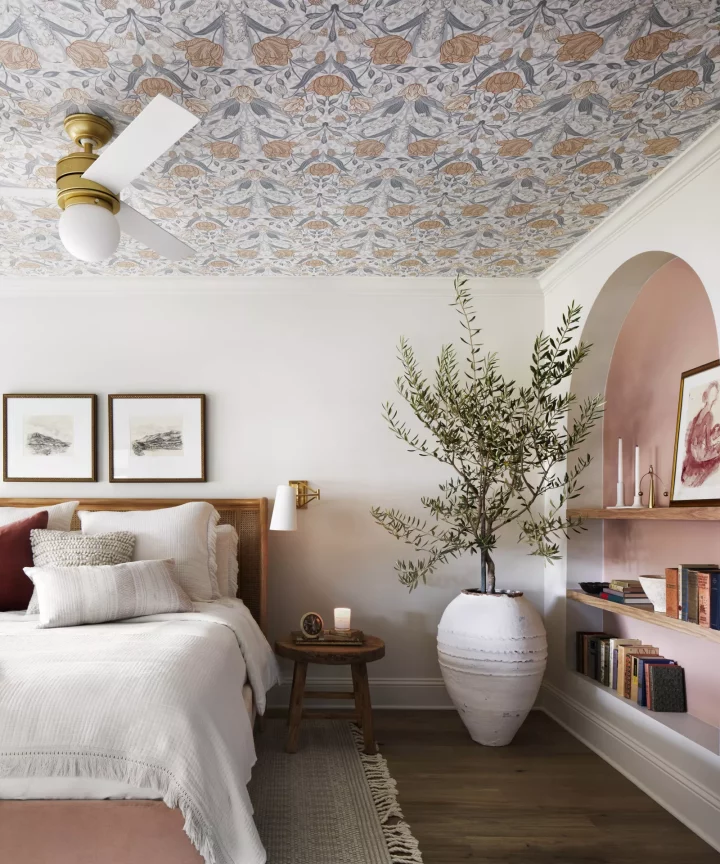
Ceilings are often overlooked as a blank canvas that can be transformed into a stunning feature using the right wallpaper. While the idea of applying wallpaper to a ceiling might seem daunting, it can actually make a significant impact on the overall ambiance and aesthetic of your space. In this comprehensive guide, we will discuss the various aspects of wallpapering a ceiling, from the benefits and challenges to choosing the right wallpaper and installation tips.
Image:
1. Why Wallpaper a Ceiling?

Image:
Wallpaper can add color, personality, and art to your space, but many people hesitate to use it out of fear that it might be overwhelming or clash with their existing décor. However, when applied correctly, wallpaper can create a dramatic transformation, particularly on a ceiling.
A. Adding Character
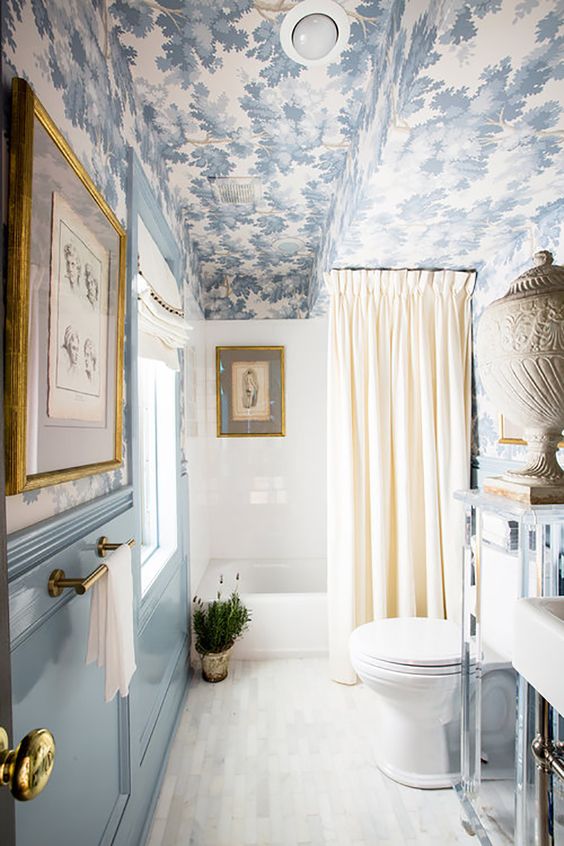
Image:
Wallpaper can introduce unique patterns, textures, and colors that can significantly enhance the character of your room. By applying an eye-catching design to your ceiling, you can draw attention upward and create a bold statement that sets your space apart from others.
B. Improving Room Proportions
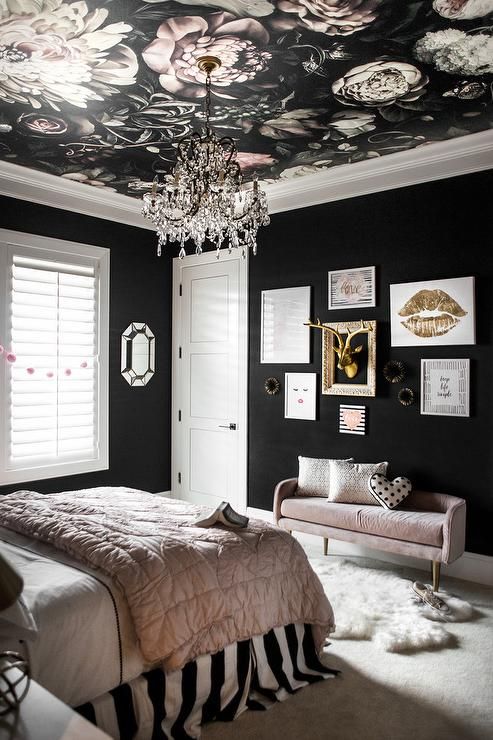
with floral wallpaper on ceiling / Image:
Utilizing wallpaper on the ceiling can also help improve the perceived proportions of a room. For example, using a pattern with vertical lines can make a low ceiling appear higher, while a horizontal design can make a narrow room seem wider.
C. Integrating Challenging Spaces
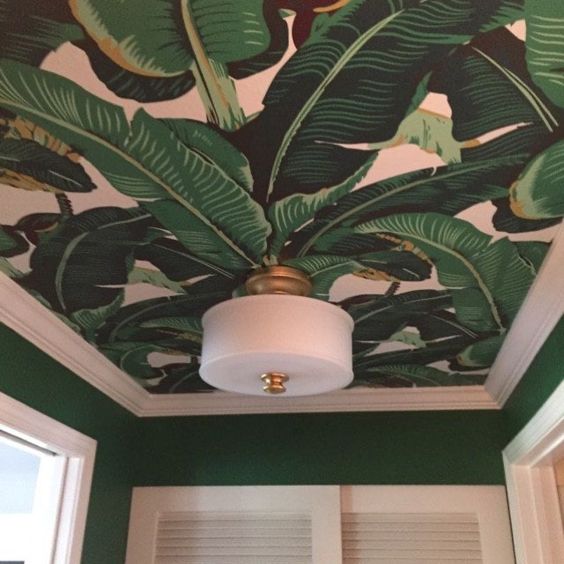
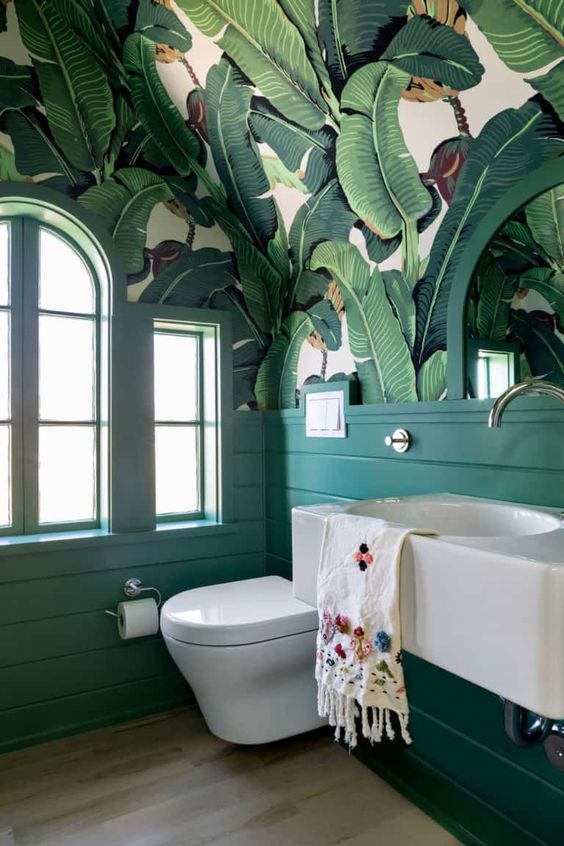
Image:
Wallpaper can be used to seamlessly blend awkward or unusually shaped spaces, such as rooms with slanted ceilings or multiple angles. By applying a cohesive pattern across the entire surface, you can create a unified and visually pleasing effect.
2. Choosing the Right Wallpaper
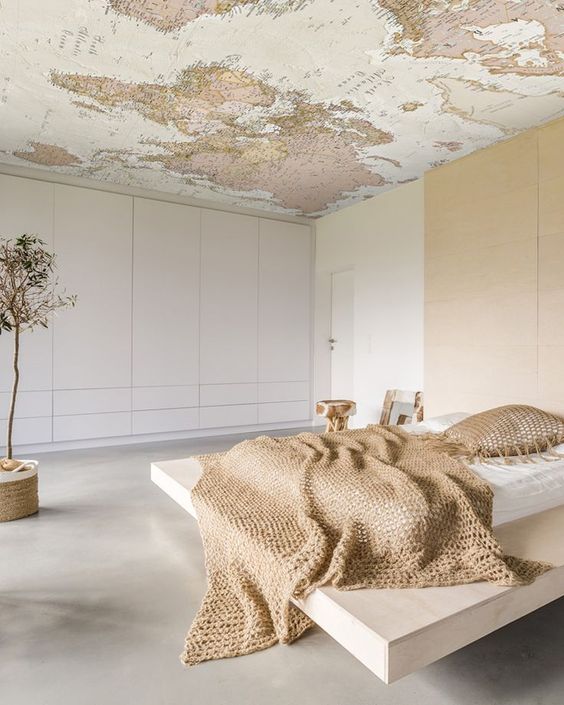
Selecting the perfect wallpaper for your ceiling is crucial, as it can significantly influence the overall look and feel of your space. Consider the following factors when making your choice:
A. Type of Wallpaper
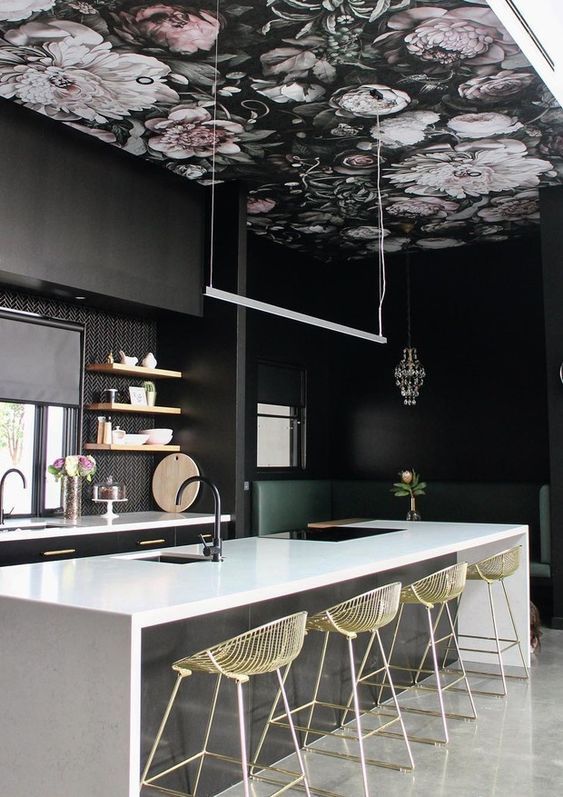
There are three main types of wallpaper available:
- Traditional wallpaper, which requires you to apply glue
- Pre-glued wallpaper, which needs water to activate the paste
- Removable (or peel-and-stick) wallpaper, which comes with a peel-off backing
Removable wallpaper is the easiest to install and remove, but it may not last as long as traditional or pre-glued options. Additionally, the selection of removable wallpaper may be more limited compared to other types.
B. Pattern and Color

The pattern and color of your chosen wallpaper will play a significant role in the overall ambiance of your room. Darker tones on the ceiling can create a cozier, more intimate feel, while lighter colors can make small rooms appear larger and brighter. Metallic designs can reflect light and enhance the sense of space in cramped areas.
Consider both small-scale and large-scale motifs when selecting a pattern. Larger patterns can be visually striking and easier on the eye, while smaller patterns can better disguise installation imperfections, making them suitable for first-time DIYers.
C. Longevity
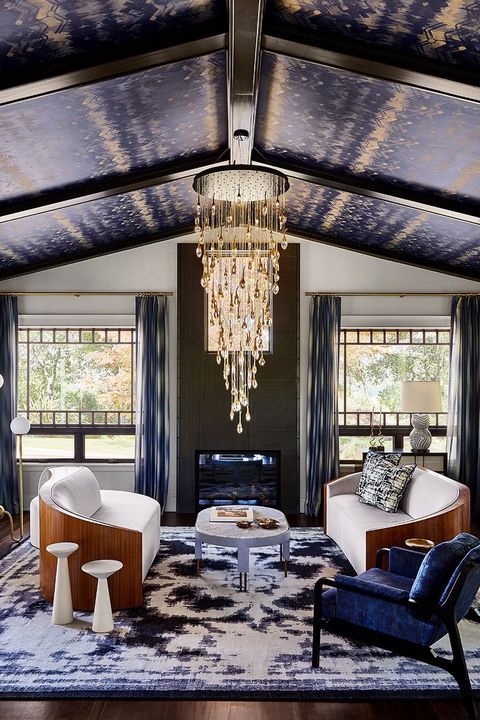
Images:
Consider the longevity of your chosen wallpaper, especially in where tastes may change over time. Removable wallpaper is easier to remove than traditional options, making it a more flexible choice for spaces that require frequent updates.
3. Preparing the Ceiling
Proper preparation is essential for a successful wallpaper installation on your ceiling. Follow these steps to ensure a smooth, clean surface:
A. Assess the Ceiling Condition
Your ceiling should be smooth, clean, and structurally sound before attempting to wallpaper it. If you have an old or cracked ceiling, wallpaper may not adhere properly and could buckle over time. Textured or popcorn ceilings are also unsuitable for wallpapering, as the texture may show through the paper. Instead, consider alternatives like beadboard, exposed wood beams, or embossed tin for a more durable decorative option.
B. Repair Imperfections
Before applying wallpaper, address any cracks or imperfections in the ceiling with spackle or joint compound. Sand the area smooth with fine-grit sandpaper to create an even surface.
C. Clean and Prime the Ceiling
Remove dust and debris from the ceiling using a duster on a long extension pole or a shop vacuum with a soft brush attachment. Follow up with a rag or tack cloth to ensure a thorough clean. Apply a specialty primer designed for wallpaper application and let it dry for at least 48 hours, following the manufacturer’s instructions. This will help prevent damage when removing the wallpaper in the future.
4. Planning the Installation
Careful planning is crucial for a successful wallpaper installation on your ceiling. Keep the following tips in mind:
A. Determine the Layout
Consider the direction and layout of your wallpaper pattern, taking into account the shape and size of your room. For example, vertical patterns can make a low ceiling appear higher, while horizontal designs can make a narrow room seem wider.
B. Measure and Cut
Measure the dimensions of your ceiling carefully, and cut your wallpaper to the appropriate size. Professionals often recommend cutting the paper to run across the shorter length of the ceiling, making it easier to handle during installation.
C. Enlist Help
Installing wallpaper on a ceiling can be challenging, so it’s a good idea to have an extra pair of hands to help with the process. Assistance can be particularly beneficial for supporting the end of the paper and passing wallpapering supplies during the installation.
5. Installing the Wallpaper
Once you have prepared and planned your wallpaper installation, follow these steps for a successful application:
A. Rent Scaffolding
Consider renting scaffolding to make the installation process easier and more comfortable. Scaffolding can be rented from big-box stores like Home Depot for around $55 per day. This will allow you to lay down close to the ceiling while you work, with your helper handing you supplies and supporting the end of the paper.
B. Apply the Wallpaper
Begin by applying the wallpaper to the center of the ceiling, working outwards towards the edges. Ensure that your lines are straight and your patterns are aligned from sheet to sheet. Use a clean, dry mop or a similar tool to smooth out any air bubbles and ensure proper adhesion.
C. Trim Excess
Once the wallpaper is in place, trim any excess paper around the edges of the ceiling using a sharp utility knife. If you have crown molding, this can help hide any minor imperfections in your trimming.
6. Pros and Cons of DIY Wallpaper Installation
While wallpapering a ceiling can be a rewarding DIY project, it’s important to weigh the pros and cons before diving in.
A. Pros
- Cost savings: DIY wallpaper installation can save you money on professional labor costs.
- Personal satisfaction: Successfully completing a wallpaper installation can provide a sense of accomplishment and pride in your home improvement skills.
B. Cons
- Difficulty: Installing on a ceiling can be challenging, particularly for those with limited experience.
- Time-consuming: The preparation, planning, and installation process can be time-consuming, especially for first-time DIYers.
- Potential mistakes: Errors in measurement, cutting, or alignment can result in a less-than-perfect result.
If you’re unsure about your ability to tackle a ceiling project, it may be worth consulting with a professional wallpaper installer to ensure a high-quality result.
7. Alternatives to Wallpapering a Ceiling
If wallpapering a ceiling isn’t the right choice for your space, consider these alternative design options:
A. Painted Ceilings
Painting your ceiling a color other than white can create a similar visual impact to wallpaper. Choose a complementary or contrasting color to your walls for a bold statement or opt for a subtle hue for a more understated look.
B. Decorative Molding
Adding decorative molding, such as crown molding or ceiling medallions, can provide visual interest and architectural detail to your ceiling without the need for wallpaper.
C. Ceiling Tiles
Ceiling tiles, such as tin or faux tin, can add texture and pattern to your ceiling while also providing a durable and easy-to-maintain surface.
8. Caring for Wallpapered Ceilings
To keep your wallpapered ceiling looking its best, follow these care and maintenance tips:
A. Dust Regularly
Use a duster on a long extension pole or a shop vacuum with a soft brush attachment to remove dust and debris from your ceiling. This will help prevent the build-up of dirt and grime that can damage your wallpaper over time.
B. Protect from Moisture
If your wallpapered ceiling is in a room with high humidity, such as a bathroom or kitchen, ensure proper ventilation to prevent moisture damage. Consider using a decorators varnish to protect the wallpaper from steam and splashes.
C. Repair Damage
If your wallpaper becomes damaged, consult with a professional wallpaper installer or follow manufacturer guidelines to repair or replace the affected area.
9. Wallpaper Removal Tips
When it’s time to remove your wallpaper, follow these steps for a smooth process:
A. Test for Removability
If you have removable wallpaper, it should peel off easily without the need for additional tools or chemicals. For traditional or pre-glued wallpaper, test a small, inconspicuous area to determine the best removal method.
B. Use the Appropriate Tools
Depending on the type of wallpaper you have, you may need to use a wallpaper steamer or chemical remover to loosen the adhesive. Follow the manufacturer’s instructions and take necessary safety precautions during the removal process.
C. Repair and Prep the Ceiling
Once your wallpaper is removed, repair any imperfections and clean the ceiling surface in preparation for new wallpaper or paint.
Conclusion
Wallpapering a ceiling can be an exciting and transformative design choice for your space. With careful planning, the right wallpaper, and proper installation, you can create a stunning visual impact that elevates the overall aesthetic of your room. Whether you choose to tackle the project yourself or enlist the help of a professional, a wallpapered ceiling can be a unique and eye-catching design element that sets your space apart.
The post appeared first on .





























